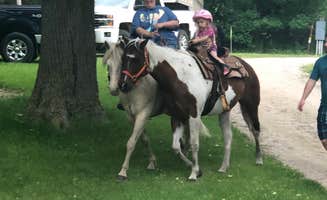Maplewood State Park offers dedicated equestrian facilities across its 9,200-acre expanse near Battle Lake, Minnesota. The park maintains multiple trail systems designed for horseback riding through diverse landscapes including woodlands, prairie ecosystems, and lakefront areas. Trail riding options range from short loops to connections with the North Country Trail for more extensive journeys. Most equestrian trails are well-maintained throughout the summer and fall seasons, with some seasonal closures during spring thaw to prevent trail damage.
What to do
Snowshoe winter trails: Lake Carlos State Park creates specialized snowshoe trails across ponds and bogs during winter months, providing unique seasonal access to normally wet areas. "I stayed here with a few friends in the winter when the park was doing their lantern-lit snowshoe trail... We had room for a truck bed camper and a pop-up clam ice fishing tent," notes Tori K. at Lake Carlos State Park Campground.
Hike fall color trails: The park system offers excellent hiking opportunities when maple trees display peak autumn colors. "Lots of maple tree's red,orange colors in fall," explains Denise D. about Maplewood State Park. The North Country Trail sections provide longer-distance options beyond the standard loop trails.
Fish lakeside sites: Several campgrounds offer direct lake access for fishing opportunities. At Beers Hike-In Site, campers find "a nice fire pit and good area for fishing right at the site," according to Shawn A., making it convenient for anglers looking to fish without traveling from camp.
What campers like
Private site options: The Knoll Loop at Maplewood provides greater separation between sites than main camping areas. "I enjoyed the privacy of these sites. Road in is a little rough," reports Levi S. from Maplewood State Park Campground. Campers seeking solitude often prefer these less-developed loops.
Lake access: Waterfront camping provides opportunities for swimming and boating. "Sites are spacious with close access to the lake from any of the lower campground sites. Large beach area for swimming and pylons to tie up boats," describes Jay H. about Lake Carlos. Many lakefront sites allow campers to keep boats nearby during overnight stays.
Wildlife viewing: Early morning hours offer opportunities to hear and see native wildlife. "Very nice and peaceful with the loons singing in the morning," mentions Denise D. about her camping experience, highlighting the natural soundscape that develops around dawn.
What you should know
Facilities vary by loop: Different camping loops offer significantly different amenity access. "The campsites are reasonable and private. But if you're not in the main loop you'll be walking for half a mile round trip," cautions Oliver I. about bathroom facilities at Maplewood. Some primitive sites require substantial walking to reach water sources or restrooms.
Seasonal considerations: Spring conditions can introduce challenges for trail users. "We tried out hiking along one of the trails. The grass was long and we quickly found ticks crawling up our leg. More trimming of the trails would make hiking more pleasant," suggests Art S. Trails generally receive maintenance before peak summer season but early visitors should prepare accordingly.
Site selection impacts: Main campground loops tend to provide better facility access but reduced privacy compared to outlying areas. "The sites in the main loop have little privacy," notes one reviewer about the tradeoffs between convenience and seclusion within the camping areas.
Tips for camping with families
Beach activities: Lake Carlos provides designated swimming areas appropriate for children. "Good lake, had a great swimming beach. Our campsite wasn't private but there are some that are surrounded by trees and private," reports Stephanie H. about Lake Carlos State Park Campground. The beach areas include gradual entry points suitable for younger swimmers.
Nature programs: State parks in the area offer structured educational activities. "Nature center is really good and all of the staff are great and friendly," mentions Jay H. regarding the interpretive opportunities available to visiting families.
Backpacking introductions: Some walk-in sites provide opportunities to introduce children to backpacking without difficult terrain. "Great backpacking site to take your family," recommends Shawn A. about the Beers Hike-In Site, noting "The walk is an easy walk" making it appropriate for families new to backpacking.
Tips from RVers
Winter camping options: Limited winter sites remain available for cold-weather camping with proper equipment. "They have 1 site (electric) available in the winter... It stayed pretty cozy!" reports Tori K. about winter RV camping at Lake Carlos with electric hookups supporting heaters.
Site sizing: Most established campgrounds accommodate standard RVs with some limitations. "We are camping/glamping in 30' fifth wheel. The sites here are spacious and cozy at the same time," shares Michele about her experience, indicating the ability to position larger rigs in designated sites.
Connectivity considerations: Despite natural settings, some campgrounds maintain reasonable cell service. "Feels like we are deep in the forest but civilization is close enough for WiFi!" notes Michele, highlighting the balance between feeling remote while maintaining communications access.


